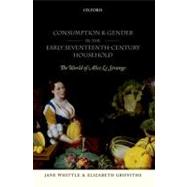Consumption and Gender in the Early Seventeenth-Century Household The World of Alice Le Strange
, by Whittle, Jane; Griffiths, Elizabeth- ISBN: 9780199233533 | 0199233535
- Cover: Hardcover
- Copyright: 5/4/2012
Lady Alice Le Strange of Hunstanton in Norfolk kept a continuous series of household accounts from 1610-1654. Jane Whittle and Elizabeth Griffiths have used the Le Stranges' rich archive to reconstruct the material aspects of family life. This involves looking not only at purchases, but also at home production and gifts; and not only at the luxurious, but at the everyday consumption of food and medical care. Consumption is viewed not just as a set of objects owned, but as a process involving household management, acquisition and appropriation, a process that created and reinforced social links with craftsmen, servants, labourers, and the local community. It is argued that the county gentry provide a missing link in histories of consumption: connecting the fashions of London and the royal court, with those of middling strata of rural England. Recent writing has focused upon the transformation of consumption patterns in the eighteenth century. Here the earlier context is illuminated and, instead of tradition and stability, we find constant change and innovation. Issues of gender permeate the study. Consumption is often viewed as a female activity and the book looks in detail at who managed the provisioning, purchases, and work within the household, how spending on sons and daughters differed, and whether men and women attached different cultural values to household goods. This single household's economy provides a window into some of most significant cultural and economic issues of early modern England: innovations in trade, retail and production, the basis of gentry power, social relations in the countryside, and the gendering of family life.







